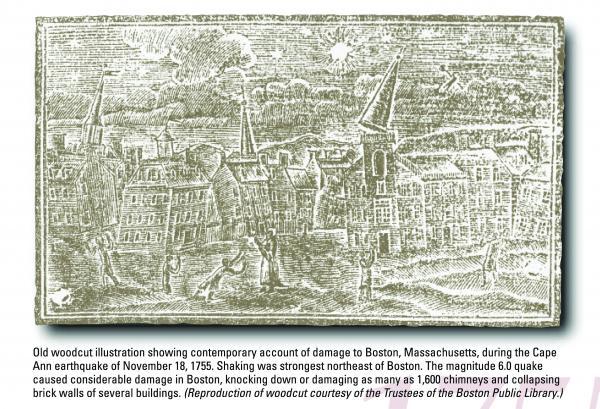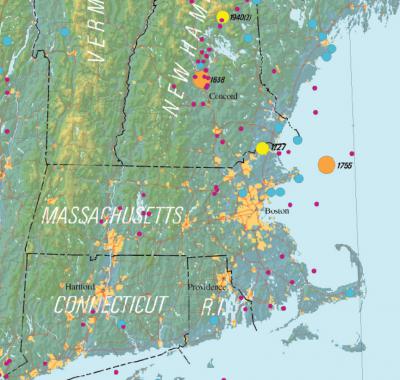October 8, 2014

Image courtesy USGS
At 10:16 a.m. next Thursday, Oct. 16, employees and school kids from across the region will be asked to “drop, cover, and hold on” under their desks a la the 1950s when the maneuver was seriously and widely practiced as a defensive measure against an atomic bomb attack by Joseph Stalin’s Soviet Union.
No Stalin and no bomb this time. State officials want Massachusetts residents to join next week in a national earthquake preparedness exercise that has been dubbed the Great Northeast ShakeOut. The under-the-desk-quickly drill is meant to get people thinking about what they’d do to stay alive in the event that they don’t get pulverized in the initial tectonic take-down.
“Drop, Cover, and Hold On” is the drill’s mantra, and The ShakeOut is actually our part of a worldwide event, with some 23 million people expected to participate — especially in hard-hit places like Japan and New Zealand.
But wait a second! When did Boston become a seismic hot-spot?
Since forever, probably. But definitely since 1755 when a 6.0 magnitude quake off the coast of Cape Ann brought down church steeples and collapsed chimneys up and down the East Coast. Was it felt here in Dorchester? You bet your colonial ass it was. And it wasn’t the last such episode, either.
In fact, New England gets rattled by small quakes all the time. Over at the Weston Observatory, Boston College scientists are constantly tracking tremors and quakes, a large majority of them too small for us to notice. Others, like the one that shook the continental northeast from Virginia and Quebec in 2011 (damaging the Washington Monument, among other things) should be big enough reminders.
If that doesn’t do it, take a gander at the most recent “hazard map” published by the US Geologic Survey. It ranks both Boston and New York City as being in a “moderate” risk zone for a serious earthquake, even though the cities do not sit anywhere near a fault line (at least, as far as we know.)
Some say we’re due for a moderate-to-large-size quake that would devastate Boston neighborhoods like the Back Bay, stocked as that neighborhood is with 19th-century brick buildings that sit on landfill that was once the Charles River.
Alan Kafka, director of the Weston Observatory and a BC professor, won’t say we’re in any imminent danger of a 1755-style quake because the historic record is just not long enough to make that kind of bold statement. “We know that magnitude 6 earthquakes can happen in the Boston area because it did in 1755,” said Kafka. “Therefore we need to prepare for that possibility. It could be 20,000 years from now, or it could be tomorrow.”
 New England quakes mapped out: The 1775 earthquake is the big circle to the right of Cape Ann.No one can say for sure what causes the earthquakes in this part of the country. “That is a great and wonderful enigma,” said Kafka. “The thing is we know we have earthquakes here and they can be quite large, but at the end of day we still don’t really know what the cause is. We know that rocks break because forces are squeezing on them. What we are trying to do is to map out what those forces are, where those weak points are and what the likelihood is of them breaking.”
New England quakes mapped out: The 1775 earthquake is the big circle to the right of Cape Ann.No one can say for sure what causes the earthquakes in this part of the country. “That is a great and wonderful enigma,” said Kafka. “The thing is we know we have earthquakes here and they can be quite large, but at the end of day we still don’t really know what the cause is. We know that rocks break because forces are squeezing on them. What we are trying to do is to map out what those forces are, where those weak points are and what the likelihood is of them breaking.”
Here’s one thing we do know: California is much more likely to get earthquakes because of the fault lines along its coast. But the granite that we sit on here in the Northeast poses threats of its own, says Kafka. “It turns out because the geology is different, east versus west, when an earthquake happens here at a given magnitude it turns out that the waves reverberate here more than on the West Coast. And if a big earthquake were to hit a crucial point, like a nuclear power plant, it could be quite the disaster.”
That is probably enough to make a person ‘drop, cover, and holdin” for the rest of the weekend. But the Massachusetts Emergency Management agency (MEMA) wants more from us.
“The main goal of the ShakeOut Drill is to prepare for a major earthquake, although your family, school or business can use this as an opportunity to think about planning for any type of natural or man-made disaster, as well,” stated MEMA Director Kurt Schwartz.
As another person who monitors tremors and shakes for a living told the Reporter this week: Be prepared. Pack “go-bags” and have them ready with emergency supplies, water and, for the cold weather months, warm clothing for the whole family. And have a place to meet up after an emergency — whether it’s an earthquake or something slightly less cataclysmic. If we do get hit someday, it could be a while before help arrives.”
If you need more survival tips or easy reading — get on the website shakeout.org/northeast/. I’ll be down the basement if you need me.
Read more about the region's earthquake history and risks here.
Topics:


